Vision 2025 - National Research Centre for Grapes
Vision 2025 - National Research Centre for Grapes
Vision 2025 - National Research Centre for Grapes
Create successful ePaper yourself
Turn your PDF publications into a flip-book with our unique Google optimized e-Paper software.
• Genetic variability among the accessions and heritability of several quantitative traits were<br />
analysed. Positive correlation was observed between yield per<br />
vine and bunch number, yield and mean bunch weight, juice<br />
percentage and berry diameter.<br />
• Evaluation of germplasm has resulted in the identification of<br />
several useful accessions. A17-3, a clonal selection from<br />
Centennial Seedless has been identified <strong>for</strong> table purpose.<br />
Kishmish Rozavis White, a mutant of Kishmish Rozavis is<br />
selected <strong>for</strong> white raisin and high yielding A18-3, a black<br />
seedless selection from an open pollinated seedling progeny of<br />
a black seeded variety <strong>for</strong> black raisin productions.<br />
Fig. 3. A-17-3<br />
Fig. 4. Kishmish Rozavis<br />
White<br />
• Clone 2A of Thompson Seedless, Red Globe, Crimson<br />
Seedless, Flame Seedless and Italia was introduced and are<br />
under field testing at various locations in the country including<br />
AICRP. Preliminary studies indicate that 2A clone of<br />
Thompson seedless and Red Globe are promising in<br />
Maharashtra and Flame Seedless in Punjab and Uttar Pradesh<br />
• Several hybrids of indigenous species and varieties with<br />
introduced cultivars were found promising <strong>for</strong> traits like early<br />
ripening and quality traits. These hybrids are under evaluation.<br />
• A computer database was developed <strong>for</strong> germplasm based on<br />
UPOV descriptors. It allows storage and retrieval of characterization data of germplasm.<br />
• 24 rootstocks and 44 other accessions were<br />
characterized with micro satellite markers. The<br />
work on molecular database is initiated <strong>for</strong> storage<br />
and retrieval of molecular data.<br />
• The confusion between two morphologically<br />
different Dogridge rootstock plants, available with<br />
Fig. 5. Micro satellite analysis of grape<br />
grape growers as Dogridge-A (America) and accessions<br />
Dogridge-B (Bangalore) was resolved based on<br />
micro satellite marker analysis and ampelometric studies.<br />
Rootstocks Dogridge-A resembled 110 Richter (110 R),<br />
which is a hybrid of V. berlandieri × V. rupestris, whereas<br />
Dogridge-B belongs to the species V. champini.<br />
• All the germplasm available in the field gene bank of the<br />
<strong>Centre</strong> was screened <strong>for</strong> resistance to downy mildew in vivo<br />
under conditions highly favourable <strong>for</strong> disease development,<br />
<strong>for</strong> two consecutive seasons. Accessions rating as resistant in<br />
vivo were further screened under controlled conditions in<br />
vitro to confirm the field ratings. Similarly other accessions<br />
of interest were also screened in vitro to determine their<br />
disease resistant status.<br />
Fig. 6. In vitro screening <strong>for</strong><br />
downy mildew resistance<br />
- note sporulation of<br />
Plasmopara viticola on<br />
leaf disc<br />
• Accessions with varying level of resistance and susceptibility selected in the above studies<br />
are being used <strong>for</strong> identification of molecular markers associated with downy mildew<br />
7





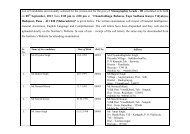
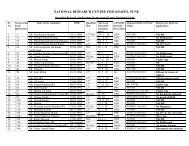

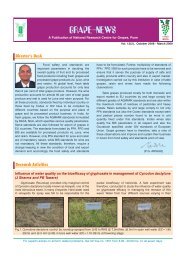

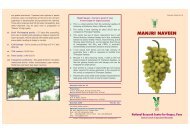
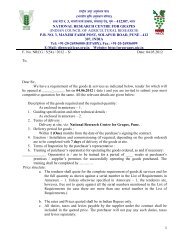



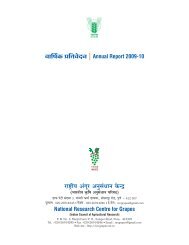
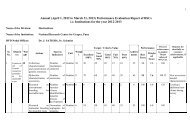
![mj]mJ{V cmcH$m{irM{ (_mBQâ¤>g) oZ`ÃÃU](https://img.yumpu.com/33367555/1/190x127/mjmjv-cmchmirm-mbqag-ozaau.jpg?quality=85)